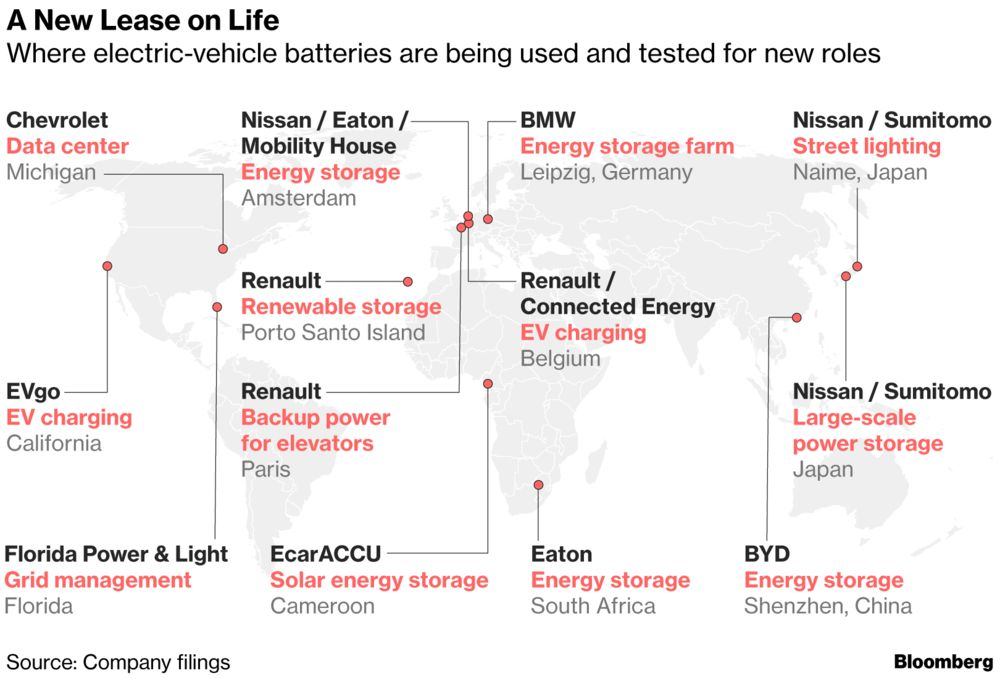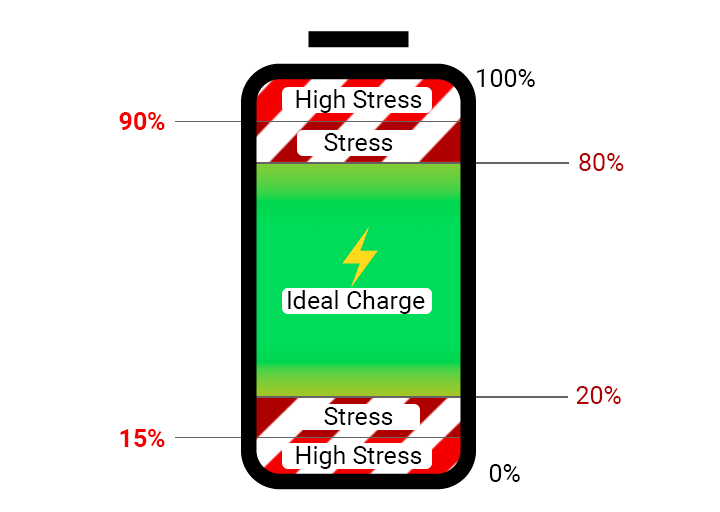Batteries
Open all sections
Close all sections
– Weight and handling
Electric car batteries weigh several hundred kilograms and are usually located in the floor of the car.
This low weight gives the cars a lower centre of gravity, adding stability when cornering and accelerating.
– Battery degradation
Most EV manufacturers offer a 8-10 year (or longer) battery warranty because, over time, EV battery capacity can gradually decrease.
A car with battery degradation will still work well, it will just have slightly less range on a full charge.
It can be an attractive option if you want a cheaper car and don’t need to travel as far in between charges.
Why batteries degrade is a hotly debated topic with many theories and ideas as to how to avoid it.
The points below are the current, generally accepted, approaches that you can take to minimise battery degradation.
Degradation can happen when a vehicle is parked, fully charged, and not used for long periods of time.
Hot temperatures (particularly over 45°C) can also reduce battery life and some cars actively
cool the battery to extend their lifetime.
Excessive fast-charging (such as several times a day over long periods of time) has been thought
to reduce battery life slightly - however this is likely due to the heat generated when fast charging.
Not all batteries are the same. A Nissan Leaf battery will, on average, degrade by about 3% per year.
A Tesla battery has a much lower rate of degradation. On average, they will lose about 10% over 10 years.
If you are concerned about battery degradation, talk to a dedicated EV dealer about
your driving needs to find a vehicle that will suit you for many years to come.
For more information, visit:
This
22 minute video
provides a very (very!)
detailed description of what battery degradation is and how to avoid it.
Sigurd’s EV guide
also contains information on dealing with battery degradation.
– Battery warranty
New Zealand new EVs come with battery warranties and conditions (such as km driven
or time) may vary. Some used vehicle dealers will also provide warranties
with their used imports.
Consumer Protection provides
resources
on their website to help with warranties and your legal rights.
– End of life - replace, reuse, recycle
– Replacing a battery
An EV battery can typically last a minimum of around 10 years before
the driving range it provides may have decreased to the point where it is
no longer useful for the owner’s needs.
Sometimes it’s possible to just replace specific parts (cells) within a battery
to revive the battery’s performance.
EVs Enhanced
in Christchurch can help with assessing if this is the right approach for you.
Blue Cars
in Auckland also offers individual battery cells for sale.
Battery upgrades are also becoming a real possibility.
The first battery upgrade trials are underway in Auckland, where old Nissan Leafs
with 24 kWh batteries are
being upgraded with 45% more range
.
There are several companies in NZ that specialize in testing, fixing and replacing EV batteries and modules.
Buying a new battery can be expensive, but this will change in the future
as battery prices are falling quickly.
Research by EECA shows that even if owners need to replace the battery,
an EV can be cheaper than a petrol car in terms of whole of life cost.
Just because a battery isn’t good enough for your EV doesn’t mean that it needs
to be thrown away. An old EV battery is still useful and can be refurbished
and reused to store energy at home, at work, or in other, lower-range EVs.
– Reusing and recycling old batteries
A common complaint about EVs is – what happens to the battery when I no longer need it?
It has been estimated that as many as 11 million tons of used lithium-ion batteries
could accumulate worldwide between now and 2030.
Even if these couldn’t be recycled, it is still worth remembering that:

An EV may produce a 300kg to 600kg battery as waste after 10 years.
Sources:

However, a small petrol car, driving 14,000km per year, will produce an average
of 20,000kg of waste CO2 over 10 years.
Sources:

It is much harder to recycle car exhaust in the air than to recycle a solid battery pack.
Lithium-ion batteries can be used for other purposes after being used in EVs,
as energy storage in homes, businesses and charging stations.
Some countries are now implementing policies that make car manufacturers and sellers
responsible for their EV batteries.
In New Zealand, the Motor Industry Association (MIA) has introduced
a code of practice for recycling old traction batteries:
The NZ Ministry for the Environment is also proposing a “Product Stewardship”
scheme that, among other things, would create regulation around how EV batteries
are handled at the end of their life.
Old EV batteries can be reused as energy storage for home, camping sites,
electricity networks, or as backup power. Around the world, companies
are exploring new ways to make use of their old battery packs.

When a battery finally reaches the end of its completely usable life, it can be
recycled. Battery recycling technology is being improved and pioneered around
the world, for example:
In New Zealand, a local E-waste recycling company,
UPCYCLE
, is leading the way
in developing battery recycling technology:
A NZ-based company
Mint Innovations
is using biotechnology to extract metals from e-waste using microorganisms!
Australia is the world’s second largest producer of lithium. Lithium Australia
is investing in new methods to recover lithium and other metals from used batteries.
For more information on recycling and reusing batteries, you could try these web pages:
– 12V battery
As well as the main battery, most EVs have a traditional 12 volt (12V)
lead-acid battery that stores power to run the car’s dashboard, computer
and accessories like lights and stereo.
Like in any other car, if the 12V battery runs flat, the car won’t start –
even if there is charge in the main EV battery.
– Battery care
As with any car, the driver of an EV has a large influence on its performance over time.
Maintaining a charge between 20 and 80% wherever possible is generally thought
to prolong battery life.
This is a very simple representation of avoiding battery stress:

Many EVs, like those made by Tesla and Hyundai, will have that additional capacity
built in. For example, the Hyundai Kona has a 67 kWh battery, but can only
be charged up to 64 kWh.
Other things you can consider are:

Frequent fast charging (multiple times per day) will increase the temperature
of the battery and can accelerate battery degradation if your EV does not
have battery cooling systems.

Some batteries have thermal management systems that use a small amount
of energy to protect the battery by regulating its temperature.

Only recharge the battery when needed instead of charging it to 100%
at every chance. Many EV owners find they only need to charge every few days.

When storing an EV for a long time, follow the battery care instructions
in the manual. Don’t store it with a fully charged battery.

Avoid exposing your battery to extreme heat or cold.

In very cold weather (below freezing), follow battery care instructions in the manual.
Check your EV’s owner’s manual for more detailed battery care advice,
information on warranty conditions and expected useful battery life.
EECA has a
best practice guide
for battery care.
EECA also has a
report on battery lifespan and degradation
.